Financing Transport Connectivity in the BIMSTEC RegionFinancing Transport Connectivity in the BIMSTEC Region looks at how to finance an overhaul of transport infrastructure in the Bay of Bengal Initiative for Multi-Sectoral Technical and Economic Cooperation (BIMSTEC) subregion. The report identifies institutional gaps in the BiMSTEC regional institutions compared with regional institutions in the European Commission, Association of Southeast Asian Nations, and the South Asia Subregional Economic Cooperation (SASEC) partnership. Author: Asian Development Bank Year: 2023 Download Tags: ADB, South Asia, Transport, Regional Cooperation Strengthening Regional Cooperation for Seamless and Sustainable ConnectivityLeast developed countries, landlocked developing countries, and small island developing states in Asia and the Pacific have been working to promote seamless transport to facilitate trade. Bangladesh, for example, has completed construction of the new Akhaura (Bangladesh) to Agartala (India) railway link, and has begun operations of Oxygen Express train carrying liquid medical oxygen as well as regular freight services between Haldibari in India and Chilahati in Bangladesh. Across South Asia, countries have also been rolling out an Electronic Cargo Tracking System under the United Nations Economic and Social Commission for Asia and the Pacific to make cargo movement more seamless. Author: United Nations Economic and Social Commission for Asia and the Pacific Year: 2023 Download Tags: Trade, South Asia, UNESCAP, Regional Cooperation, Sustainable Development Goals, Railway, Bangladesh, India Asian Economic Integration Report 2022: Advancing Digital Services Trade in Asia and the PacificAs of December 2021, 73 South Asia Subregional Economic Cooperation (SASEC) projects worth $17.43 billion had been financed. The SASEC Program was able to sustain its momentum in 2020 and 2021 in spite of setbacks brought about by the coronavirus pandemic. In 2020–2021, the Asian Development Bank (ADB) committed $2.36 billion for 13 regional cooperation and integration projects in the subregion, including five transport projects, three energy projects, and five multisector/economic corridor projects. The SASEC Secretariat is reviewing the progress of the SASEC Vision initiatives to help make coordination mechanisms more effective and to improve resource mobilization. Author: Asian Development Bank Year: 2022 Download Tags: Trade, SASEC, ADB, COVID-19, Regional Cooperation Asia–Pacific Regional Cooperation and Integration Index: Enhanced Framework, Analysis, and ApplicationsThis report discusses the framework of the Asia–Pacific Regional Cooperation and Integration Index (ARCII), which has been revised to include digital connectivity and environmental cooperation. ARCII estimates have remained stable among Association of Southeast Asian Nations members and in the Greater Mekong Subregion, while it improved for Central Asia Regional Economic Cooperation Program countries. ARCII declined slightly for South Asia Subregional Economic Cooperation countries, though improvements and links with nearby subregions are expected from joint initiatives with the Bay of Bengal Initiative for Multi-Sectoral Technical and Economic Cooperation countries. Author: Asian Development Bank Year: 2021 Download Tags: Regional Cooperation, SASEC, BIMSTEC Beyond the Pandemic: Building Back Better from Crises in Asia and the PacificThe coronavirus disease (COVID-19) pandemic has interrupted trade and tourism worldwide, leading to job losses and rising poverty. Countries need to address weaknesses in economic and social protection systems, through national initiatives that can be supported by regional cooperation. United Nations Economic and Social Commission for Asia and the Pacific member countries endorsed the Action Plan to Strengthen Regional Cooperation on Social Protection in Asia and the Pacific. This provides a platform through which governments in South Asia could work together to help mitigate the impacts of the pandemic. Author: United Nations Economic and Social Commission for Asia and the Pacific Year: 2021 Download Tags: COVID-19, Regional Cooperation, South Asia, Trade, Tourism ADB Annual Report 2020The Asian Development Bank (ADB) 2020 Annual Report details operational and financial results. In 2020, ADB continued its support for the South Asia Subregional Economic Cooperation (SASEC) road corridor in Dhaka-Northwest in Bangladesh, committing $406.1 million in loans to strengthen trade. Under the SASEC program, ADB committed $200 million to support cross-border power trade by upgrading substations in Nepal in Khimti, Barhabise, and Lapsiphedi. ADB also committed a $150 million concessional loan to improve the safety and capacity of Tribhuvan International Airport and Gautam Buddha Airport to help revive Nepal's tourism industry and address the long-term economic effects of the coronavirus pandemic. Author: Asian Development Bank Year: 2021 Download Tags: COVID-19, Energy, Regional Cooperation, SASEC, Trade, Transport Assam as India's Gateway to ASEANAssam's location in northeast India offers opportunities for enhancing cross-border trade and developing regional economic corridors spanning Bangladesh, Bhutan, India, Nepal, and countries in Southeast Asia. By developing trade and economic corridors, Assam aims to build on its vision of becoming a $75 billion economy by 2025. Author: Asian Development Bank Year: 2021 Download Tags: ASEAN, Bangladesh, Bhutan, India, Nepal, Regional Cooperation, Trade, ADB RCI Regional Integration in Bay of Bengal Region in Post-COVID-19 PeriodBay of Bengal countries face similar challenges in facing the coronavirus disease (COVID-19) pandemic. By strengthening regional cooperation, countries could bring down costs brought about by the pandemic and help hurdle barriers to the flow of people, ideas, and trade in goods and services. This paper analyzes the possible economic losses caused by the pandemic in the Bay of Bengal region. It also looks at progress in regional cooperation and suggests ways for working together in dealing with the COVID-19 pandemic. Author: Prabir De Year: 2021 Download Tags: COVID-19, BIMSTEC, Regional Cooperation Asian Economic Integration Report 2021: Making Digital Platforms Work for Asia and the PacificThis report reviews economic cooperation and integration in Asia and the Pacific. As of the end of 2019, ADB had committed a total of $13.77 billion to 60 projects under the South Asia Subregional Economic Cooperation (SASEC) partnership, including projects for improving transport connectivity, trade facilitation, and power transmission. In 2019, SASEC members revamped the SASEC Operational Plan 2016–2025 to prioritize narrowing gaps in the subregion’s transport and energy networks. The SASEC program focused on expanding multimodal connectivity to include maritime and inland water transport. Subregional health cooperation was strengthened in 2020 to improve access to health services in Asia and the Pacific. Author: Asian Development Bank Year: 2021 Download Tags: ADB, Regional Cooperation, SASEC, Transport, Trade Facilitation, Energy The Least Developed Countries Report 2020: Productive Capacities for the New DecadeThe coronavirus disease (COVID-19) pandemic is taking its toll on economies of least developed countries (LDCs). To help economies and aid their recovery from the pandemic, this report lays out proposed measures for improving productive capacities of LDCs. It looks at mechanisms for regional cooperation in the areas of green technologies, industry, and digital technologies. The report takes a look at regional integration schemes, such as the South Asian Free Trade Area, and discusses how these could be instrumental in the sustainable and inclusive recovery for LDCs. Author: United Nations Conference on Trade and Development Year: 2020 Download Tags: South Asia, UNCTAD, Least Developed Countries, Regional Cooperation, SAFTA COVID-19 and Transport in Asia and the Pacific: Guidance NoteThis guidance note outlines the effects of the coronavirus disease pandemic on the transport sector in developing Asia and the Pacific. In India, for example, rail freight traffic in April and May 2020 had decreased by 28% compared with demand in 2019. The publication shares possible measure for a post-pandemic recovery that provides greener and more resilient recovery. The publication also proposes regional cooperation bodies for coordinating cross-border freight and logistics and international air travel. Author: Asian Development Bank Year: 2020 Download Tags: ADB, Regional Cooperation, India, Transport, Logistics, ADB RCI Energy Insecurity in Asia: Challenges, Solutions, and Renewable EnergyThis book explores challenges in addressing energy insecurity in Asia. Bhutan, Myanmar, Nepal, and other energy surplus countries could export electricity and get huge economic gains, while Bangladesh, India, Sri Lanka, and other energy-deficient countries could grow faster by importing energy. Cross-border renewable energy projects could also reduce dependence on coal and oil and thus limit environmental damage. Author: Naoyuki Yoshino, Farhad Taghizadeh-Hesary, Youngho Chang, and Thai-Ha Le (editors) Year: 2020 Download Tags: ADB, Regional Cooperation, Renewable Energy New Approaches to Measuring and Assessing Regional Cooperation and Integration: Workshop HighlightsThis publication presents highlights from the Asian Development Bank (ADB) workshop on regional cooperation and integration on 16 and 17 April 2020. Discussions focused on approaches to measuring RCI and its implications for policy assessment. Mr. Ronald Antonio Butiong, Director, Regional Cooperation and Operations Coordination Division, South Asia Department, ADB, discussed regional integration indicators in South Asia Subregional Economic Cooperation (SASEC) member countries and outlined priorities for enhancing economic growth, improving social inclusion, and tackling poverty. Author: Asian Development Bank Year: 2020 Download Tags: Regional Cooperation, South Asia, SASEC, ADB, ADB RCI Summary of Proceedings of the 53rd ADB Annual Meeting of the Board of GovernorsThe Fifty-Third Annual Meeting of the Board of Governors of the Asian Development Bank (ADB) was held virtually in two stages in May and September 2020. Ms. Nirmala Sitharaman, Minister of Finance, India, called for the establishing of a regular South Asia Subregional Economic Cooperation (SASEC) meeting of finance ministers by 2021 to further strengthen regional cooperation. Mr. Ibrahim Ameer, Finance Minister, Maldives, noted how ADB has assisted Maldives through the SASEC National Single Window Project. Author: Asian Development Bank Year: 2020 Download Tags: SASEC, ADB, India, Maldives, Regional Cooperation, National Single Window Unleashing E-Commerce for South Asian IntegrationE-commerce is changing how transactions are made for goods and services. E-commerce facilitates international trade by reducing transaction costs. It also has the potential to be more inclusive of women, small businesses, and rural entrepreneurs. This report considers how e-commerce can be improved to deepen intraregional trade in South Asia. It looks at digital transacting models that reduce transaction costs and gives recommendations for regulatory reforms that could expand global participation by South Asian firms. Author: Sanjay Kathuria, Arti Grover, Viviana Maria Eugenia Perego, Aaditya Mattoo, and Pritam Banerjee Year: 2020 Download Tags: South Asia, Regional Cooperation, Regional Integration, Trade Facilitation Asia's Journey to Prosperity: Policy, Market, and Technology Over 50 YearsThis book presents factors that can explain Asia's development performance. It looks at the role of policy, market, and technology in promoting trade and investment, infrastructure, and regional cooperation and integration (RCI). In South Asia, RCI has focused on connectivity through transport, energy, and trade facilitation. The Asian Development Bank has supported RCI by initiating several subregional programs, such as the Greater Mekong Subregion (GMS), the Central Asia Regional Economic Cooperation (CAREC), and the South Asia Subregional Economic Cooperation (SASEC). Author: Asian Development Bank Year: 2020 Download Tags: ADB, SASEC, Regional Cooperation, Trade, Energy ADB Annual Report 2019The Asian Development Bank (ADB) 2019 Annual Report details ADB’s operations, activities, and financial results over the year. ADB helps foster regional cooperation and integration through its support of the SASEC Program. In 2019, ADB committed $495 million to reduce travel times along regional corridors connecting Nepal with India and Bangladesh and improve connections to Sri Lanka’s international port under the SASEC Program. Author: Asian Development Bank Year: 2020 Download Tags: ADB, SASEC, South Asia, Regional Cooperation 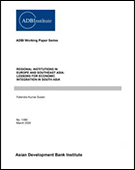 Regional Institutions in Europe and Southeast Asia: Lessons for Economic Integration in South AsiaThis working paper takes a look at the European Union (EU) and the Association of Southeast Asian Nations (ASEAN) as examples of regional institutions that were able to successfully foster economic growth and competitiveness. More specifically, the paper discusses the economic achievements of regional integration within the ASEAN and compares it with the EU. It offers lessons from the ASEAN integration that could help accelerate South Asian regional integration. It also examines the political and economic barriers hindering economic integration in South Asia, and emphasizes potential benefits regional integration and economic cooperation could bring to the South Asian Association for Regional Cooperation (SAARC) region. These include reduced economic dependence on developed countries, increased trade, and stronger economic growth in the SAARC region. Author: Falendra Kumar Sudan Year: 2020 Download Tags: Regional Cooperation, Economic Cooperation, EU, ASEAN, ADB RCI Accelerating Regional Cooperation and Integration in Asia and the Pacific: 2017 Conference HighlightsRegional cooperation and integration (RCI) plays a critical role in accelerating economic growth, reducing poverty and economic disparity, and raising productivity and employment. This conference report looks at challenges for accelerating RCI in Asia and the Pacific, with a focus on economic corridors and emerging RCI initiatives. It underscores the importance of gateway ports to multimodal transport, such as the Port of Chittagong in Bangladesh under the South Asia Subregional Economic Cooperation (SASEC) program. The report also maintains that RCI technical secretariats, such as that for the SASEC partnership, are vital to fostering RCI across Asia and the Pacific. Author: Asian Development Bank Year: 2019 Download Tags: ADB, Economic Corridor Development, Regional Cooperation, Trade, Transport, SASEC Bountiful Bangladesh: An Ocean of OpportunitiesThis special publication by the Bangladesh High Commission, New Delhi, India, celebrates India-Bangladesh relations. A chapter on regional cooperation discusses how prosperity is promoted in the region through the South Asia Subregional Economic Cooperation (SASEC). Progress in regional cooperation builds on the momentum generated in the last 18 years through SASEC. Economic performance has been impressive and South Asia is forecast to become the fastest growing subregion in Asia. Author: Bangladesh High Commission, New Delhi, India Year: 2019 Download Tags: Bangladesh, India, SASEC, Regional Cooperation 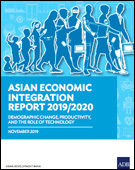 Asian Economic Integration Report 2019/2020: Demographic Change, Productivity, and the Role of TechnologyThis report reviews economic cooperation and integration in Asia and the Pacific. It reports that in 2018, the South Asia Subregional Economic Cooperation (SASEC) focused on reducing gaps in multimodal connectivity among its member countries. By the end of 2018, 52 ADB-financed projects worth $11.36 billion had been committed to SASEC projects, with an additional $106.44 million in 81 technical assistance grants. SASEC nodal officials and working groups met in Singapore in March 2018 to update the SASEC operational plan. The operational plan identified 77 projects ($45.6 billion) to be financed by SASEC members, ADB, and development partners. A holistic approach under the operational plan will build transport links with Southeast Asia and East Asia and expand regional trade markets. Author: Asian Development Bank Year: 2019 Download Tags: ADB, Regional Cooperation, SASEC, Trade Facilitation, Transport, Bangladesh, Bhutan, India, Maldives, Myanmar, Nepal, Sri Lanka 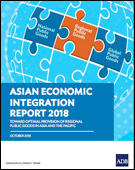 Asian Economic Integration Report 2018This report tracks the progress of regional cooperation and integration in Asia. It shows how intraregional trade grew in South Asia, Southeast Asia, and the Pacific. In South Asia, the South Asia Subregional Economic Cooperation (SASEC) has been focused on building multimodal connectivity to facilitate trade as one of its priorities. Its operational plan is being reviewed to better reflect regional project priorities in the region. SASEC is also studying how Myanmar, its newest member, is to be integrated as a vital link between South Asia, Southeast Asia, and East Asia. The chapter "Toward Optimal Provision of Regional Public Goods in Asia and the Pacific" looks at how collective action among countries can help find solutions for such transnational challenges as infrastructure connectivity, environmental degradation, and transnational health threats. Author: Asian Development Bank Year: 2018 Download Tags: ADB, Regional Cooperation, SASEC, Trade Facilitation Reinvigorating Trade and Inclusive GrowthThis report offers insights into how trade benefits the poor, those in rural areas, micro, small, and medium-sized enterprises, and women. It also shows how productivity and living standards could be raised through greater openness in key areas, such as services trade and e-commerce. The report goes on to suggest that trade policies should aim to build greater openness and urge countries to reinvest in open, rules-based global trade. Author: International Monetary Fund, World Bank, and the World Trade Organization Year: 2018 Download Tags: India, Regional Cooperation, Trade Facilitation Agreement, WTO How Would Cross-Border Electricity Trade Stimulate Hydropower Development in South Asia?South Asia uses only 20% its hydropower potential, estimated at more than 350 gigawatts. This report looks at regional electricity trade and examines the potential of hydropower development and trade in the region. It studies the importance of improving cross-border transmission interconnections to promote hydropower in South Asia. It also shows that large hydropower development would provide the additional benefits of irrigation and flood control that can be shared among neighboring countries, such as Bangladesh, India, and Nepal. Author: Govinda R. Timilsina Year: 2018 Download Tags: Bangladesh, Energy, Hydropower, Nepal, Regional Cooperation, South Asia, Trade Strategy 2030: Achieving a Prosperous, Inclusive, Resilient, and Sustainable Asia and the Pacific Under its new long-term strategy, the Asian Development Bank (ADB) continues its efforts to eradicate extreme poverty while bringing focus to a vision of a prosperous, inclusive, resilient, and sustainable Asia-Pacific. ADB’s key operational priorities include the fostering of regional cooperation and integration, covering its support for enhancing connectivity and competitiveness, promoting regional public goods, and strengthening the financial sector cooperation. ADB also aims to strengthen subregional initiatives, such as the South Asia Subregional Economic Cooperation (SASEC) Program. Author: Asian Development Bank Year: 2018 Download Tags: ADB, Energy, Regional Cooperation, SASEC, Regional Integration, Connectivity High-Speed Railway, Market Access, and Economic GrowthHigh-speed railway in the People’s Republic of China exerts positive impact effects on growth, where a 1% increase in market access leads to an increase of 0.12% in real income. Drawing insights from the effects of transport infrastructure in India, this paper suggests that high-speed railway could help promote regional cooperation and stimulate regional economic growth. Author: Wei Zou, Liangheng Chen, and Junke Xiong Year: 2018 Download Tags: ADB, Regional Cooperation, Transport, Railway ADB Annual Report 2017The Asian Development Bank (ADB) 2017 Annual Report details ADB’s operations, activities, and financial results over the year. In South Asia, finance ministers from South Asia Subregional Economic Cooperation (SASEC) member countries launched the SASEC Vision, which sets a long-term strategy for inclusive growth for the region. ADB also signed seven SASEC projects worth a combined $1.33 billion, bringing SASEC’s cumulative investment portfolio to $10.72 billion. ADB helped form SASEC working groups for cross-border trade and supported economic corridors in Bangladesh, India, and Sri Lanka to facilitate trade and investment in South Asia. Author: Asian Development Bank Year: 2018 Download Tags: ADB, Bangladesh, Bhutan, India, Regional Cooperation, SASEC, South Asia Services and Global Value Chains: The Asia-Pacific Reality, Studies in Trade, Investment and Innovation 89This book reviews issues concerning the roles of services in global value chains. It presents a framework for assessing links among different services and between services and the manufacturing sector. The book explains the contribution of services to global value chains in the Asia-Pacific region and to the world and also draws lessons with which countries could understand the importance of services and participation in global value chains to achieving sustainable development. Author: Witada Anukoonwattaka, Mia Mikic, Yuhua Zhang Year: 2017 Download Tags: ASEAN, Asia-Pacific, Energy, Global Value Chains, India, Nepal, Regional Cooperation, Sri Lanka, Sustainable Development, Sustainable Development Goals, Trade Facilitation, UNESCAP Harmonizing Electricity Laws in South AsiaMany in South Asia face electricity shortages that affect their socioeconomic development. But the region has a large hydropower potential and other energy resources that may be harnessed to drive growth in the region. This report looks at legal, regulatory, technical, and commercial requirements for energy trade to advance in the region, and gives recommendations for implementing the South Asian Association for Regional Cooperation Framework Agreement on Energy Trade. Author: Asian Development Bank and the South Asian Association for Regional Cooperation in Law Year: 2017 Download Tags: Bangladesh, Bhutan, Energy, Harmonisation, India, Industrialization, Maldives, Nepal, Regional Cooperation, South Asia, Sri Lanka, Trade, ADB RCI BIMSTEC: Rediscovering Old Routes to ConnectivityThis brief considers how Bay of Bengal Initiative for Multi-Sectoral Technical and Economic Cooperation (BIMSTEC) stands to gain by leveraging existing transport connectivity projects in the region. It looks at how initiatives, including those under the South Asia Subregional Economic Cooperation (SASEC) Program and other groups, build connectivity through standards harmonization, multimodal integration, and development of national single windows. Author: K. Yhome Year: 2017 Download Tags: BIMSTEC, Connectivity, Energy, Regional Cooperation, Single Window, Standards Harmonization, Transport 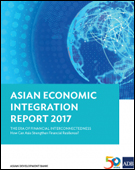 Asian Economic Integration Report 2017The 2017 Asian Economic Integration Report introduces the Asia-Pacific Regional Cooperation and Integration Index (ARCII), a composite index constructed from 26 socioeconomic indicators grouped into six dimensions: (i) trade and investment, (ii) money and finance, (iii) regional value chains, (iv) infrastructure and connectivity, (v) movement of people, and (vi) institutional and social integration. It helps capture the diversity of regional cooperation and integration, allowing Asian economies to keep track of their progress in regional integration. Within the region, ARCII shows RCI is highest in East Asia and Southeast Asia, but remains low in South Asia and Central Asia owing to gaps in infrastructure and connectivity. It is also low in the Pacific due to weak institutional and social integration. In subregional cooperation, SASEC comes third to the ASEAN and GMS. The publication highlights that regional integration can be improved through institutional and social dimensions, including efforts to remove national barriers to regional integration, adopt regional standards, and institutionalize regional frameworks, and narrowing gaps in regional connectivity and infrastructure. Author: Asian Development Bank Year: 2017 Download Tags: Regional Cooperation, Trade Facilitation, Connectivity, SASEC, GMS Regional Cooperation and Integration in Asia and the Pacific: Implementation of the Operational Plan for Regional Cooperation and Integration, 2016–2020─Corporate Progress Report 2017Regional cooperation and integration (RCI) is a valuable means for attaining national development goals. This report reviews ADB’s progress in implementing its Operational Plan for Regional Cooperation and Integration, 2016–2020, and identifies areas for improvement. It takes a close look at progress in connectivity, competitiveness, and regional public goods and collective action through projects such as the Nepal: SASEC Customs Reform and Modernization for Trade Facilitation Program. Author: Asian Development Bank Year: 2017 Download Tags: Nepal, Energy, Trade, Customs, Myanmar, Regional Cooperation, Regional Integration, SASEC, Trade Facilitation ESCAP Newsletter - 2017 SeptemberThe ESCAP Newsletter is a monthly recap of the events and other activities of the United Nations Economic and Social Commission for Asia and the Pacific (UNESCAP). This issue highlights the ASEAN-India partnership and how it could benefit the Asia-Pacific region. Dr. Shamshad Akhtar, Executive Secretary, UNESCAP, talks about the importance of sustainable development and regional cooperation and integration. The issue also features a story on strengthening technical cooperation between UNESCAP and Myanmar. Author: United Nations Economic and Social Commission for Asia and the Pacific Year: 2017 Download Tags: ASEAN, India, Myanmar, Regional Cooperation, Regional Integration, UNESCAP The Asian Economic Integration Cooperation Agreement: Lessons for Economic and Social DevelopmentThis paper focuses on the impact of regional integration on development and poverty reduction in the Association of Southeast Asian Nations (ASEAN) economic community. It examines economic growth, rapid trade, and investment expansion and looks at challenges presented by the deterioration in trade balances in Cambodia, Laos, Myanmar, and Vietnam. It also explores the role of regional integration in addressing the development gap in ASEAN countries. Author: Amelia U. Santos-Paulino Year: 2017 Download Tags: ASEAN, Free Trade Agreements, Least Developed Countries, Myanmar, Regional Cooperation, Regional Integration, WTO Asian Development Bank and India: Fact SheetUpdated yearly, the Asian Development Bank (ADB) Fact Sheet provides social and economic indicators on India, as well as information on ADB operations and contact details. Millions of people from India have benefited from improvements to basic infrastructure and services from ADB-supported development programs. ADB has approved 205 loans totaling $35.1 billion for India, and will continue to support India through the pillars of inclusive growth, environmentally sustainable growth, and regional cooperation and integration. Author: Asian Development Bank Year: 2017 Download Tags: ADB, India, Infrastructure, Regional Cooperation, Sustainability Asian Development Bank and Nepal: Fact SheetThe ADB Fact Sheet provides social and economic indicators on Nepal, as well as information on ADB operations in the country and contact details. Nepal is working toward graduation to middle-income country status and achieving the Sustainable Development Goals by 2030. ADB assistance aims to improve equitable access to education while pursuing a strategy that aims to address bottlenecks in infrastructure development in energy, transport, and urban facilities. ADB operations will also focus on agriculture, gender equality, good governance, environmental sustainability, regional cooperation, and private sector development. Author: Asian Development Bank Year: 2017 Download Tags: ADB, Nepal, Sustainable Development Goals, Infrastructure, Energy, Transport, Agriculture, Regional Cooperation, Gender Asian Development Bank and Myanmar: Fact SheetUpdated yearly, this Asian Development Bank (ADB) Fact Sheet provides social and economic indicators on Myanmar, as well as information on ADB operations in the country and contact details. ADB is supporting Myanmar in promoting inclusive and sustainable economic growth, with investments focusing on infrastructure (in energy, transport, and urban and water services), education, and rural development. Regional cooperation will remain one of the key priorities. Author: Asian Development Bank Year: 2017 Download Tags: ADB, Myanmar, Sustainability, Infrastructure, Energy, Transport, Regional Cooperation 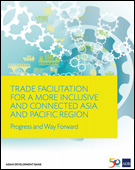 Trade Facilitation for a More Inclusive and Connected Asia and Pacific Region: Progress and Way ForwardThis report gives an overview of assessments from the 2017 global survey on trade facilitation and paperless trade in Asia and the Pacific. It looks at the implementation of trade facilitation and paperless trade measures in 44 countries in Asia and the Pacific, including how the South Asia Subregional Economic Cooperation Trade Facilitation Strategic Framework promotes development by deepening regional cooperation. The Framework covers national and subregional projects in Customs harmonization, improving cross-border facilities, and transport facilitation. The Framework also supports regulatory reforms and the development of the National Single Window Customs management system in Bangladesh, Bhutan, Maldives, and Nepal. Author: Asian Development Bank and United Nations Economic and Social Commission for Asia and the Pacific Year: 2017 Download Tags: ADB, Bangladesh, Bhutan, BIMSTEC, Maldives, Nepal, Regional Cooperation, Regional Integration, SAARC, SASEC, Standards Harmonization, Trade Facilitation, Trade Facilitation Agreement, WTO, UNESCAP, ADB RCI Regional Road Map for Implementing the 2030 Agenda for Sustainable Development in Asia and the PacificIn 2015, 150 countries set in motion the most ambitious development agenda of our time, the 2030 Agenda for Sustainable Development. Asian countries have begun translating this agenda into action through national plans and programs. However, to fully achieve the Sustainable Development Goals, countries need to examine opportunities for regional cooperation to complement the effectiveness of national mechanisms in the areas of finance, technology, capacity-building, and trade. Discussion through regional and subregional organizations can help facilitate cooperation in these key areas. Author: United Nations Economic and Social Commission for Asia and the Pacific Year: 2017 Download Tags: Regional Cooperation, SAARC, Sustainable Development Goals, Trade, UNESCAP Myanmar’s Engagement in Regional Integration: Status and Way Forward (AWP No. 169)Myanmar strategic position connects Asia’s three big markets—Association of Southeast Asian Nations, China, and India. Since 2011, Myanmar has laid down economic reforms that are unlocking the country’s potential. This working paper discusses Myanmar’s participation in regional partnerships, such as the South Asia Subregional Economic Cooperation, which it joined in 2017. It argues that such partnerships are essential in building Myanmar’s infrastructure and speeding up its growth. Author: Prabir De Year: 2017 Download Tags: ADB, ASEAN, India, Myanmar, Regional Cooperation, Regional Integration, SASEC, UNESCAP ESCAP Newsletter - June 2017The ESCAP Newsletter is a monthly recap of the key events, publications and other activities of the United Nations Economic and Social Commission for Asia and the Pacific (UNESCAP). It highlights the key issues that the UNESCAP works on and how the organization works to support member states in reaching the objectives of the Sustainable Development Goals (SDGs). This issue highlights the 73rd Commission Session of Asia-Pacific leaders on "Regional Cooperation for Sustainable Energy," which culminated with the adoption of resolutions advancing transport connectivity and sustainable energy development. Author: United Nations Economic and Social Commission for Asia and the Pacific Year: 2017 Download Tags: Energy, Regional Cooperation, UNESCAP, Sustainable Development, Sustainable Development Goals Digital Trade Facilitation: Paperless Trade in Regional Trade AgreementsMost regional trade agreements now feature one or more measures for electronically exchanging trade-related information. These measures are becoming essential to maintaining trade competitiveness and enabling effective participation in cross-border e-commerce. This paper examines the extent to which measures enabling paperless trade are included in regional trade agreements (RTAs), such as the Association of Southeast Asian Nations-India Free Trade Agreement. India leads the region with the highest number of RTAs involving paperless trade measures. Asia-Pacific RTAs now increasingly cover specific areas of paperless trade such as electronic certificates of origin and sanitary and phytosanitary certificates. Author: Yann Duval and Kong Mengjing Year: 2017 Download Tags: ADB, ASEAN, Free Trade Agreements, India, Regional Cooperation, Trade Facilitation, UNESCAP, WTO Eradicating Poverty and Promoting Prosperity in a Changing Asia-PacificThis report explores five long-term trends in the Asia-Pacific region that will shape approaches to poverty alleviation and the prospects for achieving prosperity: regional economic cooperation and integration; rural–urban transitions; demographic changes; ICT access and connectivity; and demand for natural resources. It examines the changing development context in South Asian and other economies. It also looks at opportunities created by regional cooperation and integration that intend to bring about shared economic benefits. Author: United Nations Economic and Social Commission for Asia and the Pacific, Asian Development Bank, United Nations Development Programme Year: 2017 Download Tags: ADB, Connectivity, ICT, Regional Cooperation, Sustainability, UNESCAP, UNDP, Bangladesh, Bhutan, India, Maldives, Nepal, Sri Lanka 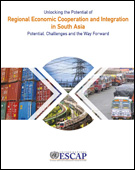 Unlocking the Potential of Regional Economic Cooperation and Integration in South AsiaAt a modest 6% of total trade, intraregional trade in South Asia stands at less than one third of its full potential. Trade barriers and inadequate infrastructure have cost South Asia over US $54 billion per year in lost export opportunities. With 309 million people living on less than $1.90 a day—the largest concentration of poverty in the world—South Asia should urgently pursue broad-based regional economic cooperation that could enable effective responses to the subregion’s developmental challenges. This report examines the state of economic integration in South Asia and identifies potential areas for further strengthening subregional linkages. It provides recommendations on policy actions to increase market integration, improve connectivity, boost investment in infrastructure development, and tackle shared vulnerabilities and risks. It calls for the consolidation and upgrading of existing trade and investment cooperation initiatives into a South Asia Comprehensive Economic Partnership. Author: United Nations Economic and Social Commission for Asia and the Pacific Year: 2017 Download Tags: BIMSTEC, Investment, Regional Cooperation, SAARC, South Asia, Sustainability, Sustainable Development, Trade, UNESCAP, Bangladesh, Bhutan, India, Maldives, Myanmar, Nepal, Sri Lanka  Asia-Pacific Sustainable Development Goals OutlookThis outlook report on the Sustainable Development Goals (SDG) offers an overview of the issues confronting the Asia and the Pacific region in eradicating poverty. Calling for greater synergies and collaboration, this report underscores that climate change and growth policies, including initiatives to improve access to energy and other forms of infrastructure, must also correspond to poverty-reduction strategies. The first knowledge product under a renewed partnership between the Economic and Social Commission for Asia and the Pacific, the Asian Development Bank, and the United Nations Development Programme, this report brings together experts and practitioners in the hope of inspiring new ideas to achieve the 2030 agenda. Author: United Nations Economic and Social Commission for Asia and the Pacific, Asian Development Bank, and United Nations Development Programme Year: 2017 Download Tags: Regional Cooperation, Trade Facilitation, Poverty Reduction, South Asia 2016 Development Effectiveness ReviewThe Development Effectiveness Review tracks development progress in Asia and the Pacific and monitors the Asian Development Bank’s (ADB) effectiveness 2010-2016. For South Asia, ADB shares results in regional cooperation, energy, and road and rail transport. ADB also approved $4.4 billion in financing for projects in South Asia during 2016. The Review includes details of ongoing and newly approved projects. Author: Asian Development Bank Year: 2017 Download Tags: ADB, Asia-Pacific, Development, Poverty Reduction, Regional Cooperation, Regional Integration, Roads, Transport, Bangladesh, Bhutan, India, Maldives, Nepal, Sri Lanka 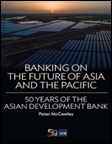 Banking on the Future of Asia and the Pacific: 50 Years of the Asian Development BankThis book tells the five-decade history of the Asian Development Bank (ADB), illustrating how the multilateral bank has grown and expanded, tackling Asia and the Pacific region’s economic development, and the evolution of its international development agenda. It discusses how ADB has helped promote regional cooperation and integration by developing subregional cooperation programs, including SASEC, which was formally established in 2001 as a project-based initiative to promote economic cooperation through the enhancement of cross-border connectivity and facilitation of trade. In 2006, the ADB Board approved the Regional Cooperation and Integration (RCI) Strategy based on four pillars: subregional economic cooperation on cross-border infrastructure and related software, trade and investment cooperation and integration, monetary and financial cooperation and integration, and cooperation in regional public goods. The RCI strategy envisaged ADB as a money bank, as a knowledge bank, as a capacity builder, and as an honest broker. Author: Peter McCawley Year: 2017 Download Tags: ADB, Development, Regional Cooperation, SASEC For a Shared Future of South Asia: Trade Insight, Vol. 12, No. 3This volume focuses on the South Asian Association for Regional Cooperation (SAARC) as a means for fostering regional cooperation to increase stability and development in the region. It urges SAARC member countries to cooperate, highlighting how economic integration and involving non-state actors can strengthen overall cooperation in South Asia, and help secure regional peace and security. It includes a discussion on the Bangladesh-Bhutan-India-Nepal as an economic corridor, South Asian drivers of regional integration, and the Belt and Road initiative. Author: South Asia Watch on Trade, Economics, and Environment Year: 2016 Download Tags: SAARC, Regional Cooperation, BBIN BIMSTEC: The Road AheadThis report examines how the Bengal Initiative for Multi-Sectoral Technical and Economic Cooperation (BIMSTEC) region can utilize its intraregional network to deepen regional cooperation and integration to better the lives of the roughly 1.5 million people living in this region. It discusses issues of trade, investment, regional value chains, and connectivity, in the context of making the BIMSTEC grouping more relevant and meaningful. With BIMSTEC's enormous potential waiting to be tapped, this report urges the grouping to take advantage of newly available opportunities and harvest low
hanging fruits, including establishment of a BIMSTEC power trade network,
promotion of business-to-business and people-to-people contact, enhancement of
regional value chains, and engaging the experience and expertise of BRICS
economies. Author: Research and Information System Year: 2016 Download Tags: BIMSTEC, Regional Cooperation, Thailand, Trade, Energy 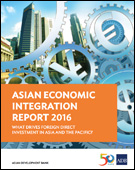 Asian Economic Integration Report 2016: What Drives Foreign Direct Investment in Asia and the Pacific?The 2016 Asian Economic Integration Report reviews regional economic cooperation and integration in Asia and the Pacific, amidst the rising global uncertainty following the United Kingdom’s referendum on leaving the European Union and the U.S. election, slower-than-expected global economic recovery, and ongoing economic restructuring in the People’s Republic of China and growth moderation. Asia faces heightened uncertainty–trade growth decelerated in 2015, falling to 2.3% in 2015; subregional trade linkages continue to strengthen, but inter-subregional trade linkages weakened; and non-tariff measures have become major obstacles to trade. In South Asia, SASEC cooperation has improved access to key markets in smaller economies, reduced real trade costs and behind-the-border barriers to stimulate investment; and enabled cross-border power exchanges to ensure power supply affordability, reliability, and overall grid stability. However, the SASEC agenda needs to be framed within wider integration processes taking place in Asia in the next decade to enhance economic linkages, and harness the full potential of Asian integration. Author: Asian Development Bank Year: 2016 Download Tags: ADB, ASEAN, Asia-Pacific, Development, FDI, Free Trade Agreements, Regional Cooperation, Regional Integration, SASEC, Trade Facilitation, UNCTAD, Bangladesh, Bhutan, India, Maldives, Nepal, Sri Lanka 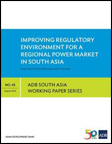 Improving Regulatory Environment for a Regional Power Market in South AsiaCountries in South Asia continue to experience poor access to energy, energy shortages, and concerns for energy security. Bilateral energy trading, with its limited scope, leaves untapped the vast economic, reliability, and environmental benefits of energy cooperation in the region. Improving access to modern energy sources through regional cooperation contributes toward economic growth, and better and more sustainable living conditions in South Asia. Regional energy cooperation supports the development of regional primary energy sources to generate electricity, cross-border transmission infrastructure, and a regional framework that will coordinate energy resource development and trade of electricity across the region. However, this will only be possible with appropriate policies and harmonized legal and regulatory frameworks in all necessary systems. Experience across the world indicates that such legal and regulatory changes can be accomplished successfully. Author: Anoop Singh, Priyantha Wijayatunga, and P. N. Fernando Year: 2016 Download Tags: Energy, Regional Cooperation, South Asia, ADB RCI  Summary of Proceedings of the 49th Annual Meeting of the Board of GovernorsThis publication provides a summary of the proceedings of the 49th Annual Meeting of the Asian Development Bank (ADB) Board of Governors, held in Frankfurt, Germany from 2-5 May 2016. It also includes statements from the Governors of ADB member countries, including SASEC countries. In his address, Mr. Abul Maal Muhith, Governor, Bangladesh, called for further acceleration of ADB's regional cooperation and integration strategy, which could play a critical role in accelerating economic growth, reducing poverty and economic disparity, and raising productivity and employment and environmental sustainability in Bangladesh, and lauded ADB's support in the signing of the landmark Bangladesh-Bhutan-India-Nepal Motor Vehicle Agreement (BBIN MVA). Mr. Arun Jaitley, Governor, India, highlighted India's strong and renewed commitment to regional cooperation in South Asia, which was demonstrated with the signing of the BBIN MVA and ongoing negotiations for the India-Myanmar-Thailand Highway. He also emphasized partnership between ADB and India in the development of the East Coast Economic Corridor, with initial focus on the ‘Vizag Chennai Industrial Corridor’, which will play a major role in connecting India to global production networks and value chains in the ASEAN region. Author: Asian Development Bank Year: 2016 Download Tags: ADB, Bangladesh, India, Regional Cooperation, Poverty Reduction 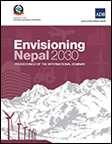 Envisioning Nepal 2030Nepal's National Planning Commission has undertaken the initiative to develop Nepal’s long term Development Strategy 2030 by engaging with international development experts, development partners, policy makers, and representatives of civil society organizations in the international seminar 'Envisioning Nepal 2030'. With the aim of serving as a guideline for Nepal’s graduation from Least Developed Country status by 2022, achieve the Sustainable Development Goals in the post-Millennium Development Goals era, and become a middle-income country by 2030, the seminar identified challenges and opportunities, and discussed how a fast-paced and sustainable inclusive growth could be achieved. In his opening remarks, Asian Development Bank Vice President Wencai Zhang, underscored the importance for Nepal to strategically position itself within a broader regional cooperation to transform itself from a landlocked into a landlinked country. Author: Nepal National Planning Commission Year: 2016 Download Tags: Nepal, Hydropower, Energy, Regional Cooperation Thirty Years of SAARC: Society, Culture and DevelopmentThis book traces economic and political issues through SAARC’s 30-year journey. The collection provides a well-researched assessment of SAARC, looks at policy directives for the future, and examines constraints to cooperation in South Asia. The publication argues that countries need to consider the benefits of economic cooperation if they wish to play an increased role in globalization. Author: Rajiv Kumar and Omita Goyal, editors Year: 2016 Download Tags: SAARC, Regional Cooperation, Development 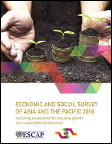 Economic and Social Survey of Asia and the Pacific 2016The 2016 edition of UNESCAP’s Economic and Social Survey of Asia and the Pacific encourages the region to rethink its development strategy. As 2016 marks the beginning of the 2030 Agenda for Sustainable development, the period is also characterized by an outlook clouded by uncertainty, with growth expected to plateau at about 5% in 2016 and 2017. Exports bound for developed economies continue to move sluggishly and domestic demand remain moderate. Thus, to bolster economic growth, the Survey recommends adopting a development model that raises domestic and regional demand. Along with active labor market policies and greater social protection, regional economic cooperation and integration--in areas covering capital markets, intraregional trade, infrastructure development, and energy and information and communications technology (ICT) connectivity--can be an important avenue for boosting domestic and regional demand. Author: United Nations Economic and Social Commission for Asia and the Pacific Year: 2016 Download Tags: Economic Growth, Regional Cooperation, ICT, Energy Innovation Networks and the New Asian RegionalismAsian development and the strengthening of regional cooperation and integration (RCI) worldwide will experience the effects of growing structural reform issues, such as slowing productivity growth, increasing economic inequalities and systemic vulnerabilities. Hence, future RCI policies will need to complement domestic policy reform. This book examines factors that drive the regional economic integration of nations, and explains how beneficial integration can generate broad-based, equitable wealth in Asia. Author: Hans-Peter Brunner Year: 2016 Download Tags: Regional Integration, Regional Cooperation, Economic Integration 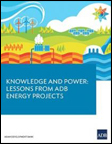 Knowledge and Power: Lessons from ADB Energy ProjectsThis publication highlights good practices and lessons learned from Asian Development Bank projects in energy, which comprised 26.5% of ADB's total lending commitments from 2008 to 2014. It discusses how the region's energy sources are utilized, providing updates on recent developments and challenges, highlighting the need for sustainable energy initiatives. Featured projects include the Green Power Development Project in Bhutan, which developed clean energy for regional use and promoted cross-border power trade. As the first infrastructure-focused public-private partnership in Bhutan, it also illustrated how projects can benefit with the active participation of the private sector, foreign parties, and commercial and public financial institutions. Also featured is the Bangladesh-India Electrical Grid Interconnection Project, which reduced Bangladesh's energy deficiency by enabling the country to affordably import 500 megawatts of electricity from India. This electrical link laid the groundwork for a regional energy market, an important step toward achieving a functioning regional electricity network in South Asia. Author: Asian Development Bank Year: 2015 Download Tags: Energy, Bangladesh, Bhutan, India, Regional Cooperation SAARC: The Way AheadThis Observer Research Foundation Issue Brief examines the South Asia Association for Regional Cooperation as a regional grouping that is almost three decades old. It discusses trade arrangements such as the South Asian Preferential Trading Arrangement aimed towards a higher level of intraregional trade liberalization and economic cooperation, including the South Asia Free Trade Area for reduction of Customs duties on traded goods. The paper further studies areas of energy, connectivity, foreign direct investment, trade in services and subregional cooperation. The South Asia Subregional Economic Cooperation Program is offered as one of the steps in the direction of having a viable option for subregional cooperation. Author: Jayshree Sengupta Year: 2015 Download Tags: Regional Cooperation, SAARC, Trade, Connectivity, Energy, FDI, Investment, Free Trade Agreements, Services, South Asia Cross-Border Electricity Cooperation in South AsiaStrengthening cross-border electricity cooperation in South Asia can be part of the solution for providing adequate and reliable electricity. This World Bank Policy Research Working Paper reviews the status of cross-border electricity cooperation in South Asia, identifies key regional-level barriers to expand cross-border cooperation and trade in South Asia, and discusses the extent to which current domestic sector policies impede greater cross-border electricity cooperation. Finally, the findings offer policy recommendations on increased cross-border trade and cooperation. Author: Anoop Singh, Tooraj Jamasb, Rabindra Nepal, and Michael Toman Year: 2015 Download Tags: Energy, Regional Cooperation, Regional Trade, Bangladesh, Bhutan, India, Maldives, Nepal, South Asia, Sri Lanka, Trade, Trade Policy, WB Economic and Social Survey for Asia and the Pacific: Part 2 – Balancing the Three Dimensions of Sustainable Development: From Integration to Implementation This theme study outlines a conceptual framework, a set of strategies and policy options, and offers perspectives on institutional frameworks for integrating the three dimensions of sustainable development – economic growth, social progress and environmental protection. Regional cooperation is critical in maximizing opportunities for building synergies between the three dimensions. Initiatives at the regional level should consider establishing a regional road map, supporting regional economic integration initiatives, and strengthening regional platforms, including the United Nations and the multilateral system. Author: United Nations Economic and Social Commission for Asia and the Pacific Year: 2015 Download Tags: Asia-Pacific, Economic Integration, Regional Cooperation, Economic Growth, Environment, Sustainability, UNESCAP Trans-Pacific Partnership versus Regional Comprehensive Economic Partnership: Control of Membership and Agenda Setting This ADB Working Paper argues that the formation of regional integration frameworks can be best understood as a dominant state’s attempt to create its own regional framework where it can exercise some exclusive influence. It explores the Trans-Pacific Partnership and the Regional Comprehensive Economic Partnership (RCEP). It also analyzes the strategies of key players such as ASEAN, Korea, India, Japan, USA and China. India is part of the RCEP negotiating process and sees increased presence in Southeast and East Asian markets, closer relations with ASEAN, and increased connectivity with North Asia and Oceana as benefits from involvement in RCEP. Author: Asian Development Bank Year: 2014 Download Tags: Regional Integration, India, Connectivity, ADB, Regional Cooperation, ASEAN 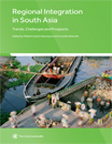 Regional Integration in South Asia: Trends, Challenges and ProspectsThis study presents an assessment of trade and economic cooperation among South Asian nations, explores emerging challenges, and highlights policy issues to foster regional integration. It provides perspectives on potential new areas of cooperation such as investment, regional supply chains, energy, and cross border transport networks. The four areas of focus are: potential gains from South Asian regional integration, key areas for cooperation resulting in effective regional integration, country perspectives of regional cooperation, and case studies on bilateral cooperation. This volume aims to further contribute to policy discourse on effective regional cooperation with perspectives from Bangladesh, India, Maldives, Nepal, Pakistan, and Sri Lanka.
Author: Mohammad A. Razzaque, Yurendra Basnett (Eds.) Year: 2014 Download Tags: South Asia, Regional Integration, Regional Cooperation, Bangladesh, India, Maldives, Nepal, Sri Lanka, Energy SASEC BrochureThis promotional brochure is a concise introduction to the South Asia Subregional Economic Cooperation (SASEC) Program, highlighting the main areas of regional cooperation and activity. It includes facts and figures about SASEC projects in transport, trade facilitation, energy, and ICT. Author: Asian Development Bank Year: 2014 Download Tags: SASEC, Trade Facilitation, Regional Cooperation, ICT, ADB, Bangladesh, Bhutan, India, Nepal, Maldives, Sri Lanka, Energy, Transport, Connectivity, Myanmar 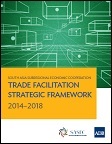 SASEC Trade Facilitation Strategic Framework 2014-2018The South Asia Subregional Economic Cooperation (SASEC) Trade Facilitation Strategic Framework 2014-2018 builds on the momentum of member countries over recent years in forging ahead with many significant improvements to facilitate, and ultimately increase, trade in the subregion and with the rest of the world. It supports the mission of the SASEC Transport and Trade Facilitation Strategy “to promote the prosperity of the subregion by facilitating the efficient movement of trade across the borders”, and focuses on five priority areas: customs modernization and harmonization; standards and conformity assessment strengthening; cross-border facilities improvement; through-transport facilitation; and institution and capacity building. Author: Asian Development Bank Year: 2014 Download Tags: SASEC, Trade Facilitation, Regional Cooperation, Transport, Trade, Customs, Standards, Harmonisation, Regional Integration, ADB, Bangladesh, Bhutan, India, Maldives, Nepal, Sri Lanka, South Asia, ADB RCI ASEAN, PRC, and India: The Great TransformationThis joint study by the Asian Development Bank and the Asian Development Bank Institute highlights the Association of Southeast Asian Nations, the People’s Republic of China, and India (collectively referred to as ACI economies) as drivers of the global economy. It explores links among ACI economies and how these may shape regional and global competition and cooperation. The study also notes that Asia’s leading economies can foster a positive outcome through a paradigm shift toward inclusive, green, and knowledge-led growth. Adoption of low-carbon, green growth strategies can help place ACI economies on a sustainable growth path. Furthermore, infrastructure and human capital investments can link ACI economies through region-wide free trade and investment agreements. Author: Asian Development Bank and Asian Development Bank Institute Year: 2014 Download Tags: India, Asia-Pacific, Regional Cooperation, ADB, ASEAN, Investment 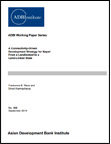 A Connectivity-Driven Development Strategy for Nepal: From a Landlocked to a Land-Linked StateTransforming Nepal from a landlocked into a land-linked state, the authors argue, could be key to unlocking the country's much-awaited growth. With its strategic location between India and the People's Republic of China, a connectivity-driven development strategy could energize Nepal's lackluster post-conflict economic performance. Further, Nepal implements a multi-track approach to promoting regional cooperation and integration in connectivity with its neighbors, reinforced through participation in South Asian Association for Regional Cooperation, Bay of Bengal Initiative for Multi-Sectoral Technical and Economic Cooperation, and South Asia Subregional Economic Cooperation. By identifying ten priority projects that could further boost Nepal's connectivity, the paper also discusses how strengthening Nepal's transport, energy, and trade links could benefit the region. However, the authors also warn against “internal threats” to Nepal's development—corruption and the country's difficult political situation. Author: Pradumna B. Rana and Binod Karmacharya Year: 2014 Download Tags: Nepal, Economic Corridor, Regional Trade, Connectivity, Development, Economic Growth, SASEC, India, Regional Cooperation, Regional Integration, SAARC, BIMSTEC, Transport, Energy, Trade Economic and Social Survey of Asia and the Pacific 2014This 2014 edition of UNESCAP's flagship publication emphasizes the importance of furthering regional connectivity in Asia-Pacific—a region which, despite significant reductions in poverty levels, is now witnessing rising income inequality, both within and between countries. It calls for driving the region's growth by exploiting the interdependence and synergies of five elements: trade and transport connectivity, ICT networks, energy connectivity, people-to-people networks, and promotion of knowledge-based economies, and advocates approaching connectivity as a regional public good. Author: UNESCAP Year: 2014 Download Tags: Economic Integration, Regional Cooperation, Poverty Reduction, Asia-Pacific, Connectivity, Energy, ICT, Bangladesh, Bhutan, India, Maldives, Sri Lanka, Trade, Transport, UNESCAP 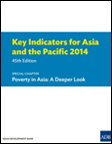 Key Indicators for Asia and the Pacific 2014This year's edition presents an in-depth inquiry on poverty in Asia, tackling whether the $1.25/day extreme poverty standard still accurately depicts minimum living standard of the poor in Asia and the Pacific. Using this broad measure, the poverty rate is projected to fall to 24.5% for South Asia by 2030, if recent economic growth trends continue. However, considering the current national poverty line average among today's less developed economies in the region, an Asia-specific extreme poverty line is more accurately estimated at $1.51/day, increasing Asia’s poverty rate in 2010 by 9.8%, and ��of a large economy like India by 15%. Hence, despite huge gains made, reducing poverty remains a pressing challenge in Asia and the Pacific. This book proposes several measures to counteract worsening poverty, including �close �regional cooperation which can reduce a country’s vulnerability, and urgent policy actions that promote economic growth and prioritize climate change adaptation and mitigation. Author: Asian Development Bank Year: 2014 Download Tags: Poverty Reduction, Disaster Risk, Regional Cooperation, Asia-Pacific, Bangladesh, Bhutan, Economics, Energy, India, Maldives, Milennium Development Goals, Nepal, Sri Lanka, Sustainability, Transport Assessing the Costs of Climate Change and Adaptation in South AsiaThis book discusses the economic costs and benefits of unilateral and regional actors on climate change adaptation in Bangladesh, Bhutan, India, the Maldives, Nepal, and Sri Lanka. It provides the total economic loss throughout the 21st century and estimates the funding required for adaptation measures to avert potential losses. Huge impacts are likely on vulnerable sectors in the region, with South Asia losing on average nearly 2% of its gross domestic product by 2050. Results of the study will aid climate change adaptation in the region, including initiatives for regional cooperation. Author: Mahfuz Ahmed and Suphachol Suphachalasai Year: 2014 Download Tags: Climate, South Asia, Regional Cooperation, Energy, Bangladesh, Bhutan, India, Maldives, Nepal, Sri Lanka 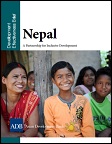 Nepal: Development Effectiveness Brief 2014Nepal has the potential to achieve more inclusive growth and can largely benefit from regional cooperation and integration with its developing neighbors. It is also benefiting from South Asia Subregional Economic Cooperation, a flagship ADB-supported program that promotes economic cooperation and integration in areas of trade facilitation (custom modernization and transport connectivity), power development, trade, and tourism development. This brief further explores ADB’s contribution to inclusive development and poverty reduction, energy, and transport. Exporting energy when surplus is available is one way of meeting seasonal demand by subregional cooperation and power trade. Transport infrastructure is also another key ingredient to equitable, inclusive growth that can address challenges such as lack of market access, inadequate roads, and poor connectivity. Author: Asian Development Bank Year: 2014 Download Tags: Nepal, Regional Cooperation, South Asia, ADB, Connectivity, Energy, Roads, SASEC, Trade, Transport 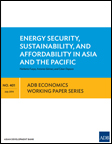 Energy Security, Sustainability, and Affordability in Asia and the PacificEnergy security, sustainability, and affordability from 2010 to 2035 for Asian Development Bank’s Asia and Pacific members are calculated in this working paper, including potential benefits of integrating energy systems regionally. Based on business-as-usual and alternative scenarios, outlook on SASEC member countries by 2035 include (i) dramatic improvement in Bhutan's energy efficiency, (ii) slight decrease in Bangladesh's energy intensity—although carbon dioxide will increase in its primary energy mix, as dependence on fossil fuels rise, and (iii) decrease in energy self-sufficiency of SASEC member countries by 2035, but improved energy affordability. Since renewable energy sources and importation of energy may be capital-intensive, requiring additional tariff support, regional cooperation can enhance affordability and energy security—with Bhutan and Nepal standing to benefit greatly from energy integration in South Asia. Author: Norberto Fueyo, Antonio Gómez, and César Dopazo Year: 2014 Download Tags: Energy, Bhutan, Nepal, Sustainability, Asia-Pacific, ADB, Regional Integration, SASEC, South Asia, Bangladesh, Sustainability, Renewables, Tariff, Regional Cooperation The Long and Winding Road: How WTO Members Finally Reached a Trade Facilitation Agreement The conclusion of the Agreement on Trade Facilitation at the Bali negotiations in December 2013 marked the end of a journey that lasted almost a decade. As the first multilateral trade agreement successfully negotiated by World Trade Organization (WTO) ministers, it broke new ground in the decentralized, bottom-up way the negotiations were structured; in the manner the capacities and resources of developing countries were addressed; and in how the Agreement has shifted the system’s focus beyond policy barriers toward process frictions. The negotiated outcome is likely to have an impact not just on Trade Facilitation, but on the WTO and the multilateral trading system as a whole. Author: Nora Neufeld Year: 2014 Download Tags: Trade Facilitation, Trade Policy, Regional Cooperation, WTO, India Trade Facilitation and Paperless Trade ImplementationThis paper reports survey findings on progress in implementing various trade facilitation and paperless trade measures made by 29 countries in Asia and the Pacific, including six SASEC member countries. Factors considered include pre-arrival clearance, post-clearance audit, National Single Window, and authorized operator programmes. The survey reveals that while countries have prioritized automation and paperless trade at the regional level, there is an urgent need for regional arrangements that will facilitate cross-border exchange of trade-related electronic documents and information to enable smoother trade facilitation. Author: Tengfei Wang and Yann Duval Year: 2014 Download Tags: Trade Facilitation, Regional Cooperation, Trade, Asia-Pacific, SASEC, Single Window, UNESCAP, Customs, Bangladesh, Bhutan, India, Maldives, Nepal, Sri Lanka 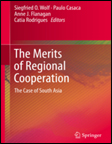 The Merits of Regional Cooperation: The Case of South AsiaThis book makes the case for a re-strengthened South Asian Association for Regional Cooperation (SAARC), arguing that regional integration is a key factor for countries in South Asia to succeed economically and increase confidence among potential foreign investors. SAARC's inroads in improving border crossings, transport routes, and infrastructure are improving weak levels of trade within the region. However, these efforts are insufficient; they need to go hand-in-hand with further improving bilateral relations – and SAARC is in a good position to facilitate these negotiations. Spanning a wide range of subjects, including international relations, strategic affairs, environment, politics and economic issues, the publication aims to show the huge potential of South Asia as a region. Author: Siegfried O. Wolf, Paulo Casaca, Anne J. Flanagan, and Cátia Rodrigues Year: 2014 Download Tags: Regional Cooperation, ASEAN, Bangladesh, Europe, India, SAARC, South Asia Together We Deliver: 10 Stories from ADB-Supported Projects Together We Deliver showcases ten ADB projects across Asia and the Pacific that demonstrate clear development impacts, replicable best practices, and valuable use of innovation. Among those highlighted is SASEC's Green Power Development Project in Bhutan, which is boosting the national economy through clean energy exports to India and also funding social programs that bring electricity to more than 8,500 rural poor households. The book also features a rural road project in India that connects remote communities to schools, hospitals, and other facilities. Capturing a wide range of ADB's assistance, the book portrays how ADB is changing for better the lives of many in Asia and the Pacific region. Author: Asian Development Bank Year: 2014 Download Tags: Regional Cooperation, Bhutan, India, Development, Energy SAARC Biz: The Inevitability of South Asia SAARC Biz is a monthly publication of the SAARC Chamber of Commerce & Industry and features a report on the 'Inevitability of South Asia'. While the term 'South Asia' is commonly accepted, it argues that regionalism is far from being implemented on the ground. For instance, SAARC was accepted as a concept of cross-border regionalism but was hobbled due to budget constraints and restrictive mandates. Connectivity across national frontiers is needed to jump-start regionalism and improve lives in the most deprived parts of the Subcontinent. Author: SAARC Chamber of Commerce and Industry Year: 2014 Download Tags: South Asia, Regional Cooperation, SAARC, Industrialization, Regional Integration, Poverty Reduction, Gender, Least Developed Countries, Connectivity, Agriculture, Bangladesh, Youth, India, Environment, Investment, Tourism, Renewables 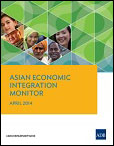 Asian Economic Integration Monitor - April 2014The Asian Economic Integration Monitor, a semiannual review of regional economic cooperation and integration in Asia covers regional economic updates, intraregional trade, financial integration and investment, and the importance of disaster risk financing instruments. The Theme Chapter: Insuring Against Asia’s Natural Catastrophes discusses market solutions and the role of government in developing disaster risk financing and strengthening financial resilience. The economic update section encourages strengthening regional cooperation in surveillance and financial safety nets, and deepening economic links. Inter-subregional trade between each subregion and the rest of Asia is rising, except in South Asia, while financial integration continues to deepen across the region. Author: Asian Development Bank Year: 2014 Download Tags: Regional Cooperation, Regional Integration, South Asia, Disaster Risk, Climate, Bangladesh, Bhutan, India, Maldives, Nepal, Sri Lanka, Transport The Political Economy of Asian RegionalismThis book reviews the political economy of Asia's economic cooperation and integration and focuses on the innovations needed for current institutional reform in the region. It analyzes Asian regionalism after the global financial crisis including free trade agreements. The book also discusses the possible formation of a region-wide economic community. Author: Giovanni Capannelli, Masahiro Kawai Year: 2014 Download Tags: Economics, Regional Cooperation 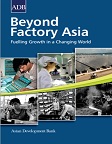 Beyond Factory Asia: Fuelling Growth in a Changing WorldThis paper assesses the challenges of Factory Asia – a model of regional networks connecting production centers in different Asian economies. It forms part of regional and global value chains and constitutes an important source of growth in the region. Regional cooperation is vital to the success of Factory Asia, which calls for greater South-South cooperation to leverage knowledge in domestic manufacturing, allowing countries such as India to leapfrog to higher value chains. For Bangladesh and Sri Lanka with small domestic markets, strategic options include carving out a niche in lower-value manufacturing. The paper further argues that policymakers should be wary of expanding or increasing the number of free trade agreements for the growth or spread of production networks. Author: Asian Development Bank Year: 2013 Download Tags: South Asia, Regional Cooperation, Trade Policy, Manufacturing, Exports, Small and medium enterprises, India, Agriculture, Bangladesh Connecting South Asia and Southeast Asia: Interim ReportThis joint ADB-ADBI study focuses on how improved physical connectivity (infrastructure) and associated institutional connectivity (software) can enhance more effective economic integration between the two subregions. The report reviews economic ties, identifies issues and constraints, and explores better connectivity and closer economic integration. It also examines major developments in South Asia-Southeast Asia trade and investment, economic cooperation, role of economic corridors, and regional cooperation initiatives. Author: ADB and ADBI Year: 2013 Download Tags: Infrastructure, Economic Integration, Regional Cooperation, Trade, Transport, Trade Facilitation, Economic Corridor, Energy  Attracting Foreign Direct Investment: What Can South Asia's Lack of Success Teach other Developing Countries?Despite South Asian nations experiencing increased foreign direct investment (FDI) flows over the past decade by gaining a large share of cross border investments, FDI inflows in South Asian countries still remain the lowest relative to gross domestic product (GDP) among developing country regions. This paper uses an empirical model that accounts for possible trends in convergence in the ratio of FDI to GDP between countries and cross-sectional data for 78 countries from 2000 to 2011. In examining the historical patterns of South Asia’s FDI and its connection with the policy environment, policymakers can identify constraints to FDI and boost potential for broad-based growth. Author: David M. Gould, Congyan Tan and Amir S. Sadeghi Emamgholi Year: 2013 Download Tags: South Asia, Trade Policy, FDI, GDP, Investment, Governance, Transparency, Economic Growth, Financial Sector, Regional Cooperation, Trade The ASEAN Economic Community: A Work in ProgressThis publication explores the barriers and impediments to the realization of an ASEAN Economic Community (AEC), and to what extent its self-imposed deadline of 2015 for achievement of an AEC is more of a milestone of progress than a firm target. It examines whether the AEC is achievable, the obstacles faced in achieving it, and the measures required to help it become a reality. Author: Asian Development Bank Year: 2013 Download Tags: Regional Cooperation, Regional Integration, Trade Policy, ASEAN, Economic Integration, Regional Cooperation, ADB, Regional Integration, Services, Global Value Chains, Non-Tariff Measures, Asia-Pacific Trade Agreement, India, Trade Facilitation The ASEAN Economic Community: A Work in ProgressThis publication explores the barriers and impediments to the realization of an ASEAN Economic Community (AEC), and to what extent its self-imposed deadline of 2015 for achievement of an AEC is more of a milestone of progress than a firm target. It examines whether the AEC is achievable, the obstacles faced in achieving it, and the measures required to help it become a reality. Author: Asian Development Bank Year: 2013 Download Tags: Regional Cooperation, Regional Integration, Trade Policy, ASEAN, Economic Integration, Regional Cooperation, ADB, Regional Integration, Services, Global Value Chains, Non-Tariff Measures, Asia-Pacific Trade Agreement, India, Trade Facilitation ADB Regional Cooperation Operations Business Plan (RCOBP) 2014-2016 for South AsiaADB's third Regional Cooperation Operations Business Plan (RCOBP) 2014-2016 for South Asia under its South Asia Regional Cooperation Strategy (RCS) 2011-2015 details a cumulative indicative lending program of $3.3 billion and maintains focus on improved regional connectivity, increased cross-border trade, and strengthened regional economic cooperation. Author: Asian Development Bank Year: 2013 Download Tags: Regional Cooperation, Regional Integration, Bangladesh, Bhutan, India, Maldives, Nepal, Sri Lanka, Trade Facilitation, Transport, Energy, SAARC Deepening Economic Cooperation between India and Sri LankaThis book analyzes the performance and impact of the India-Sri Lanka free trade agreement over the past decade and suggests the way forward. India became an important source of imports for Sri Lanka immediately after the implementation of the free trade agreement. Author: Asian Development Bank Year: 2013 Download Tags: Regional Cooperation, Trade Policy, India, Sri Lanka, Trade, Economic Cooperation, India-Sri Lanka Free Trade Agreement, Free Trade Agreements, Services, Trade Facilitation, Exports, Import ARIC Information Pack: October 2013The ARIC Information Pack compiles news and events on regional cooperation & integration (RCI) that corresponds to ADB's four RCI pillars: cross-border infrastructure, trade and investment, money and finance, and regional public goods. A special feature on the implications of the US recovery to Asian exports also appears in this issue. Author: Asian Development Bank Year: 2013 Download Tags: Regional Cooperation, Regional Integration, ADB, SASEC 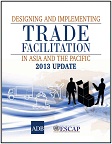 Designing and Implementing Trade Facilitation in Asia and the PacificThis reference book was published to support the implementation of trade facilitation measures and reforms in Asia and the Pacific. It includes operational guidance on assessing the status of trade facilitation, the measures and reforms needed, how to design trade facilitation initiatives, and how to implement them at national and regional levels. The book is intended to assist policy makers, practitioners, and economists by bridging the gap between theory and practice. The revised 2013 version includes updated statistical figures and data, information on actual trade facilitation policies and practices, and the most recent research on trade facilitation. Author: Asian Development Bank / United Nations Economic and Social Commission for Asia and the Pacific Year: 2013 Download Tags: Trade Facilitation, Regional Cooperation, Regional Integration, Trade Policy, Economic Corridor, Sanitary and Phytosanitary Measures, Technical Barriers to Trade, Revised Kyoto Convention, Customs, Customs Valuation, Bangladesh, Bhutan, India, Nepal, Maldives, Sri Lanka, Services Unlocking Bangladesh-India Trade: Emerging Potential and the Way ForwardThis working paper breaks down the importance of trade cooperation between Bangladesh and India by taking a closer look at the impacts of Bangladesh's increased market access to India, and their improved border connectivity. Employing data from national government resources and multilateral development organizations including the International Monetary Fund, World Bank, and World Trade Organization, the study provides an estimate of the trade potential of Bangladesh and India, and calculates the implications on costs of trade facilitation, among others. It also discusses ongoing challenges in bilateral relations and provides recommendations that will enable larger gains for the two contiguous countries. Author: Prabir De, Selim Raihan, and Sanjay Kathuria Year: 2012 Download Tags: Trade, Trade Facilitation, Regional Cooperation, Bangladesh, India, WB, WTO, Bilateral Trade Regional Integration and Economic Development in South AsiaSouth Asian leaders have made it a priority to tackle key regional issues such as poverty, environment degradation, trade and investment barriers and food insecurity, among others. This book considers the leadership of the South Asian Association for Regional Cooperation (SAARC) and the interaction with civil society in the process of South Asian regional cooperation and integration, and discusses how the emerging urgency in the provision of regional public goods provides an excellent opportunity to add to the successes in South Asian regional integration. Author: Sultan Hafeez / Rahman Sridhar Khatri / Hans-Peter Brunner Year: 2012 Download Tags: Economic Corridor, Regional Cooperation, Regional Integration, SAARC, SAFTA, Bangladesh, Bhutan, India, Maldives, Nepal, Sri Lanka Regional Cooperation and Integration Through Cross-Border Insfrastructure Development in South AsiaThis paper aims to identify the links between cross-border infrastructure development and poverty reduction. With South Asia being home to around 40% of the world's poor, there is a great need to boost intraregional trade through greater cooperation and integration. Regional integration promises to increase the region's capacity to connect with global production networks and participate in the global economy with greater efficiency. Author: P.V. Srinivasan Year: 2011 Download Tags: Regional Cooperation, Regional Integration, South Asia, Bangladesh, Bhutan, India, Maldives, Nepal, Sri Lanka, Poverty Reduction 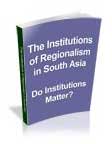 The Institutions of Regionalism in South Asia - Do Institutions Matter?This paper assesses the contribution of key institutions of regional cooperation and integration (RCI) in South Asia, and suggests ways in which the Asian Development Bank and other development partners can strengthen their support. It attempts to enhance understanding on the interplay between politics and RCI, including how good bilateral political relations or improvements have advanced RCI. With the overall political environment growing increasingly open to RCI, the paper suggests the time has come for the South Asian Association for Regional Cooperation (SAARC) to consider strengthening the capacity of the SAARC Secretariat to meet the growing challenges and work load of managing the anticipated increase in RCI. Author: Prabhu Ghate Year: 2011 Download Tags: Regional Cooperation, Regional Integration, Development, SAARC, Trade, Services, Trade Facilitation, Energy, Free Trade Agreements, SAFTA, Bangladesh, Bhutan, India, Maldives, Nepal, Sri Lanka, Transport Energy Trade in South Asia: Opportunities and ChallengesThe South Asia Regional Energy Study was completed as an important component of the regional technical assistance project Preparing the Energy Sector Dialogue and South Asian Association for Regional Cooperation Energy Center Capacity Development. It involved examining regional energy trade opportunities among all the member states of the South Asian Association for Regional Cooperation. The study provides interventions to improve regional energy cooperation in different timescales, including specific infrastructure projects which can be implemented during these periods. Author: Sultan Hafeez Rahman / Priyantha D. C. Wijayatunga / Herath Gunatilake / P. N. Fernando Year: 2011 Download Tags: Energy, Regional Cooperation, Regional Integration, SAARC, Trade, Bangladesh, Bhutan, India, Nepal, Maldives, Sri Lanka Binding Contraints to Regional Cooperation and Integration in South AsiaThis paper examines the benefits of regional cooperation and integration, focusing on the cost of neglecting to address the binding constraints to regional cooperation and integration. Component papers in this volume analyze the current state of play, and identifies the binding constraints to achieving more efficient transport corridors, regional energy trade and trade facilitation in the region. Author: Gilberto M. Llanto Year: 2010 Download Tags: Regional Cooperation, Economic Integration, Trade Facilitation, Energy, Bangladesh, Bhutan, India, Maldives, Nepal, Sri Lanka, Transport Infrastructure for a Seamless AsiaThe study reviews regional infrastructure being enhanced through regional cooperation in Asia and examines major issues and challenges. It suggests a framework for pan-Asian infrastructure cooperation, anchored on a long-term vision of creating a seamless Asia that will not only enhance the region's competitiveness and extend its global reach, but also help reduce poverty and promote greater environmental sustainability. Author: Asian Development Bank / Asian Development Bank Institute Year: 2009 Download Tags: Regional Cooperation, Regional Integration, Transport, Trade Facilitation, Connectivity, India, Bangladesh, Bhutan, Nepal, Maldives, Sri Lanka, Asian Highway, Trans-Asian Railway Network, Energy, Myanmar Pan-Asian IntegrationIn today's globalized world where the economic fates of nations are inevitably linked, weathering the present economic storm for Asia will increasingly depend on harnessing regional dynamics particularly on the trade front. Pan-Asian Integration: Linking East and South Asia is a rich volume of perspectives from leading thematic experts on regional patterns of trade and investment, trade-related infrastructure, trade facilitation, among others. Author: Asian Development Bank Year: 2009 Download Tags: Regional Cooperation, Regional Integration, Trade Policy, Transport, Trade Facilitation, Economics, India, Free Trade Agreements 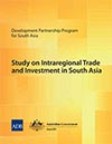 Study on Intraregional Trade and Investment in South AsiaThis study broadens and deepens intraregional cooperation and integration in trade and investment among South Asian countries. It showcases the benefits of regional integration and presents an array of policy recommendations to maximize and realize such gains. Three parallel initiatives are needed: first, reduce nontariff barriers to deepen the South Asian Free Trade Area (SAFTA); second, expand SAFTA's scope to include investments and services; and third, focus on key industries to succinctly demonstrate the process and benefits of reforms. These translate into six component studies: (i) the Role of Trade Facilitation in South Asian Economic Integration; (ii) Country Investment Studies for Bangladesh, India, Nepal, and Sri Lanka; and (iii) Textile and Clothing Industry. The study invigorates the debate and focus on South Asian integration as a means to further growth and reduce poverty. Author: Asian Development Bank / Australian Government Year: 2009 Download Tags: Trade Policy, Trade Facilitation, Regional Cooperation, Regional Integration, Bangladesh, India, Nepal, Sri Lanka, SAFTA Quantification of Benefits from Economic Cooperation in South AsiaThe study examines the implication of the South Asian Free Trade Agreement (SAFTA) on South Asian countries and on the region as a whole, employing both a quantitative and qualitative assessment on the outcomes of SAFTA. The research aims to provide support in the formulation of concrete policy measures for trade to ensure greater gains for the region, while at the same time mitigating potential negative impacts. Economic and social assessments through analytical tools and rational causal chain analysis further enrich the study. Author: Asian Development Bank / United Nations Conference on Trade and Development Year: 2008 Download Tags: Economic Corridor, Regional Cooperation, Regional Integration, SAFTA, Free Trade Agreements, Trade Facilitation, Transport, Services, SAARC, Bangladesh, Bhutan, India, Maldives, Nepal, Sri Lanka Emerging Asian Regionalism-A Partnership for Shared ProsperityThe study summarizes important issues related to Asian regionalism. Viewing regional cooperation as a necessary tool for coping with the consequences of interdependence, the book discusses several pressing issues, such as integrating production, improving financial cooperation, and managing macroeconomic interdependence to create a stable architecture for an Asia-wide cooperation. Author: Asian Development Bank Year: 2008 Download Tags: Economic Corridor, Regional Cooperation, Regional Integration, Asia, ASEAN, SAARC, Bangladesh, Bhutan, India, Nepal, Maldives, Sri Lanka SASEC ICT Development Master PlanThis report represents the first comprehensive multilateral ICT development plan. Its primary objective is to create a framework that will support the already existing ICT plans of Bangladesh, Bhutan, India, and Nepal and help these SASEC countries collaborate more effectively with each other. Author: Asian Development Bank Year: 2006 Download Tags: ICT, Regional Cooperation, Regional Integration, SASEC, Bangladesh, Bhutan, India, Nepal Cross- Border Private Sector Cooperation in ICT Among SASEC CountriesThis study explores the issue of cross-border cooperation in ICT among private sectors in Bangladesh, Bhutan, India, and Nepal. It discusses the ICT policy frameworks of the four SASEC countries, and gives an update on improvements in their ICT infrastructure and the state of their ICT infrastructure linkages. It further provides a set of recommendations for the way forward. Author: Asian Development Bank Year: 2004 Download Tags: ICT, Regional Cooperation |




